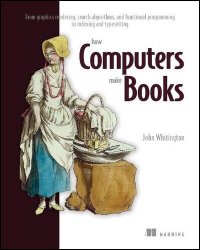 Название: How Computers Make Books: From graphics rendering, search algorithms, and functional programming to indexing and typesetting (Final)
Название: How Computers Make Books: From graphics rendering, search algorithms, and functional programming to indexing and typesetting (Final)Автор: John Whitington
Издательство: Manning Publications
Год: 2024
Страниц: 176
Язык: английский
Формат: epub
Размер: 64.6 MB
Learn about computer science by exploring the fascinating journey it took to make this book!
How Computers Make Books introduces what’s wonderful about computer science by showing how computers have transformed the art of publishing books. Author and publishing software developer John Whitington reveals the elegant computer science solutions invented to solve big publishing challenges.
In How Computers Make Books you’ll discover:
How human descriptions are translated into computer programs
How a computer can understand document formatting
How a program decides where to print ink on a page
Why computer science is so interesting to computer scientists, and why it might interest you
…and much more!
How do computers represent all the different languages and letters used by humans? How do we compress a book’s worth of complex information so it can be transferred in seconds? And what exactly is a computer program? This book answers all those questions by telling the story of how it was created!
about the technology
Computers are part of every step in creating a book, from capturing the author’s words as a digital document to controlling how the ink gets onto the paper. How Computers Make Books introduces basic computer science concepts like file formatting, transfer, and storage, computer programming, and task automation by guiding you through the modern digital printing process.
about the book
This book takes you on a journey from the plain white page, weaving through typesetting, making gray images from black ink, electronic file formats, and more. It makes computer science come alive as you see how every word, illustration, and page has its own story. You’ll even learn to write your own simple programs and discover hands-on what’s so intoxicating about Computer Science.
Chapter 1 introduces the book and explains who it is for and why it was written. We then start our exploration from nothing. We have a plain white page on which to place marks in ink to make letters and pictures. How do we decide where to put the ink? How can we draw a convincing straight line? Using a microscope, we will look at the effect of putting these marks on real paper using different printing techniques.
Chapter 2 shows how to draw letters from a realistic typeface—letters that are made from curves and not just straight lines. We will see how typeface designers create such beautiful shapes and how we might draw them on the page. A little geometry is involved, but nothing that can’t be done with a pen and paper and a ruler. We fill these shapes to draw letters on the page and deal with some surprising complications.
Chapter 3 describes how computers and communication equipment deal with human language, rather than just the numbers, which are their native tongue. We see how the world’s languages may be encoded in a standard form and how we can tell the computer to display our text in different ways.
Chapter 4 introduces some actual computer programming in the context of a method for conducting a search through an existing text to find pertinent words, as we might when constructing an index. We write a real program to search for a word in a given text and look at ways to measure and improve its performance. We see how search engines use these techniques every day.
Chapter 5 explores how to get a book’s worth of information into a computer.
Chapter 6 deals with compression—that is, making words and images take up less space without losing essential detail. However fast and capacious computers have become, it is still necessary to keep things as small as possible. As a practical example, we consider the method of compression used when sending faxes.
Chapter 7 introduces more programming but of a slightly different kind. We begin by seeing how computer programs calculate simple sums, following the familiar rules we learn in school. We then build more complicated things involving the processing of lists of items. By the end of the chapter, we will have written a substantive, real program.
...
Chapter 11 finishes up, showing how our book gets into the hands of the reader, either in print or electronically. Along the way, we learn the details of the PDF standard for document exchange, which combines text, fonts, drawings, and photographs into a single unit.
what's inside
How human descriptions are translated into computer programs
How a digital computer thinks about print documents
How a program decides where to print ink on a page
How the history of typesetting shows up in modern books
about the reader
For the curious-but-clueless about computer science—and anyone interested in how computers make books!
Скачать How Computers Make Books: From graphics rendering, search algorithms, and functional programming to indexing and typesetting